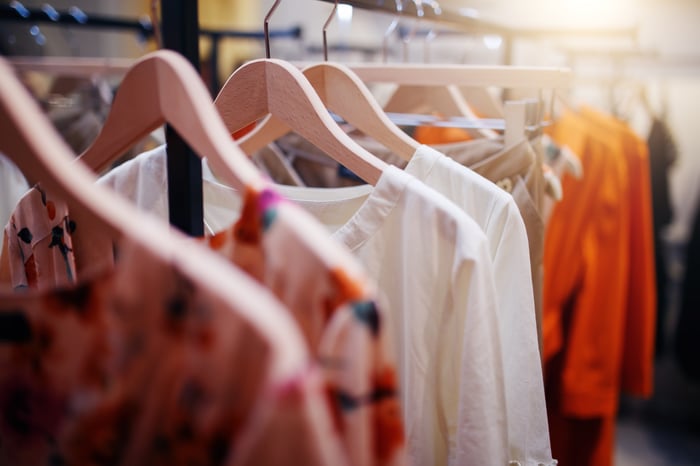Just like the Champion and Vans Brands, Ralph Lauren (RL 0.72%) is hoping for a second coming in the retail universe, and it might just happen. Buoyed partly by consumer confidence in a stronger economy, retail is a booming sector, and brands that once lagged are now looming large thanks to Gen Z-er's love for retro.
Apparel is currently in the top 20% of the 250-plus industries that Zacks ranks. And, according to Zacks, the top 50% of industries that it ranks outperforms the bottom 50% by a factor of more than 2 to 1. Still, before you go long on Ralph, consider that the company has a long way to go before it is likely to claim victory in the competitive retail space.

Image source: Getty images
A rebirth of blue
Let's face it, there's only so much lycra and polyester that one can wear in a season, and denim has been cast aside in a cruel and crazy hoodie and yoga pant-obsessed decade. Thus, Ralph Lauren might have a clever and cunning plan by attempting to revive denim.
In August, the company launched a global advertising campaign focused on denim, titled "Wear Your Story." The concept is based on the nostalgia of wearing denim for those of us who are, unfortunately, that old. Advertising features demographic representatives such as a student, father, mother, and yogi.
A "Family Campaign" launched in April was similarly demographic-inclusive highlighting multi-generational and same-sex couples in the spring 2019 Polo collection.
As for denim, new designs are sustainably sourced with personalized printing to order. The younger crowd will appreciate the bespoke trend as well as the firm's Better Cotton Initiative, a step toward sustainably sourcing 100% of the brand's denim and reducing water use by 20% across all operations and value chain by 2025. Ralph Lauren is one of 32 leading global fashion textile companies to commit to a climate, biodiversity, and ocean pact.
Perhaps the biggest and latest coup was highlighting sustainability in its designs of ball person's uniforms at the 2019 US Open Tennis tournament. Now that was a good choice as far as marketing initiatives are concerned, and totally aiming at the right consumer group.
Ralph Lauren is climbing but confusing
Still, Lauren needs to redefine its consumer. And there is a theory that this might happen just as the Gen Z favorites such as Champion and Lululemon begin begin to decline.
Brands like Vans and Champion have staged a comeback thanks to the Gen Z's love of social media followers and their influencers. Whatever brand royalty-think Beyoncé and Jay-Z-are wearing on Instagram today is next week's cash cow.
Ralph Lauren, on the other hand, is side-stepping this phenomenon and relying on tried and true traditional marketing. So far, however, the iconic brand has failed to show a significant uptick in consumer awareness or demand, perhaps due to a lack of creativity in its typical choice of channels to reach its market, such as mobile.
Another hurdle to overcome is that the brand is also confusing for consumers. According to Ralph Lauren, it targets the upper-middle to upper classes who have a sizable disposable income. The company also touts a clothing range for "the sportier end of the spectrum" (think polo and rugby enthusiasts) while its lines are "classic, elegant, and sophisticated" yet "formal."
So, which is it? Sporty or formal? I'm confused. And emphasizing polo and rugby seems to totally target elites, not the upper-middle class.
So what is the effect of Lauren's new initiatives, and will they pay off if there is a fall-off in athleisure?
Financials and a potential payoff
It turns out that Ralph Lauren is already showing positive signs. After a 7% decline in revenues in 2019, the company announced expected 1% growth for this year at its third-quarter earnings report. Not great. However, the most recent quarterly report showed an earnings surprise of 6.63%.
Also, expected earnings of $0.93 per share in the third quarter were actually $1.07, delivering a surprise of 15.05%. For EPS, the company has surpassed consensus EPS estimates four times over the past four months.
There was also a 21% jump in digital commerce revenue that compensated for flat brick-and-mortar sales. Most interestingly, a sign of confidence was a buyback of 400 million shares in the first three-quarters of fiscal 2019 and an announcement that the company plans to spend a billion dollars on buybacks through fiscal 2020. These latest numbers are turning heads.
Bottom line, if you find yourself tolerating a long checkout line to buy a new pair of jeans, consider going long on some Ralph stock while you're at it. Just check the numbers before you do.





